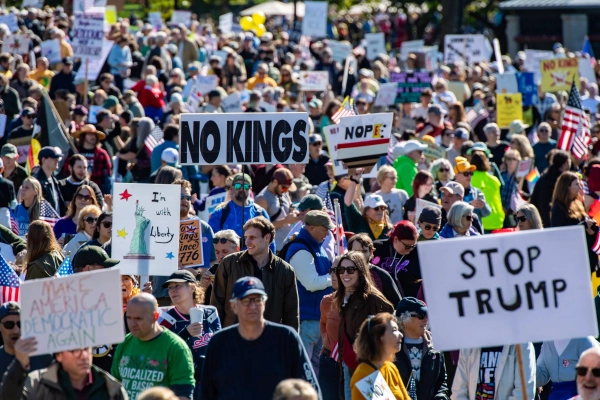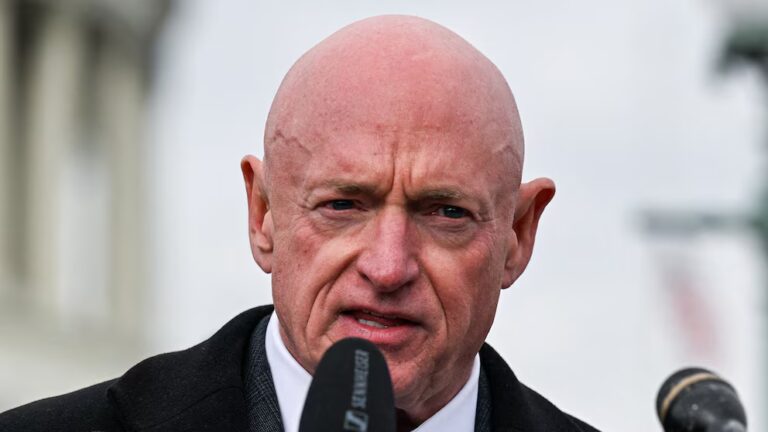“`html 
Definitive figures remain outstanding, although initial indications propose that Saturday’s “No Kings,” anti-Trump demonstrations represented the most prominent single-day demonstration occasion since 1970 — and perhaps the most sizable peaceful demonstrations throughout US history. In excess of 2,700 occasions unfolded across all 50 states, according to the organizers, suggesting the involvement of possibly 7 million Americans.
Sen. Elizabeth Warren epitomized this sentiment during her address at the Boston gathering, articulating that “standing in opposition to a would-be dictator — that constitutes patriotism. … Rejecting the presence of troops occupying our cities — that embodies patriotism. And conducting peaceful demonstrations to safeguard our democracy — that defines patriotism.”
However, notwithstanding such vigor and zeal, the anti-Trump resistance continues to encounter a conundrum: notwithstanding all the demonstrations and large-scale mobilizations of Trump’s initial term, he ultimately secured reelection with heightened backing. This prompts numerous unresolved inquiries: precisely how impactful can structured demonstration efforts prove? What insights can demonstrators glean since then, and what constraints apply to the achievements of mass mobilization? Furthermore, how might these movements evolve when confronted with an administration that appears eager to employ every governmental authority against its perceived adversaries?
To address these inquiries, among others, I engaged in dialogue with Theda Skocpol, the Victor S. Thomas Professor of Government and Sociology at Harvard University, and a distinguished authority regarding both the historical context and practicalities of political organization within the US. And while Skocpol, who undoubtedly does not endorse Trump, harbors optimism concerning the potential implications of the No Kings demonstrations, she remains firmly anchored to her perception of the overarching objective of mass demonstrations. (Clue: Within the American framework, she posits that it bears minimal relation to the 3.5% statistic you might have encountered).
This discussion underwent modifications to enhance lucidity and conciseness.
The No Kings demonstration transpired anew this past weekend. What constituted your preliminary response to it? What anticipations did you possess? Were they fulfilled, or did anything come as a surprise?
It proved inspiring to witness such an expansive quantity of individuals across a multitude of [distinct] types of locations. I surmised such an outcome as probable, yet certainty remains elusive until realization. Nevertheless, conspicuously, numerous individuals emanated from varied locales and voiced apprehension regarding prevailing circumstances within the nation — coupled [with] a somewhat lighthearted demeanor, potentially advantageous considering the existing context. Consequently, I posit that it embodies a moment of mutual support for the majority, indeed, of Americans who express discontent with the current trajectory of affairs.
Did any aspect differentiate the demonstrations this weekend from the mass demonstrations observed during Trump’s initial administration?
My research associates and I scrutinized both the surge of Tea Party demonstrations that proliferated in 2009, commencing on Tax Day, recognized as the most substantial [single-day demonstration] regarding scale and geographic distribution across the nation. Additionally, we examined, four years subsequently, the Resistance to Trump, which commenced with augmented rapidity and achieved peak magnitude and proliferation during the post-inaugural Women’s Marches in January 2017. In such regard, the No Kings demonstrations observed thus far bear resemblance to both the Tea Party and Resistance movements, inasmuch as these constituted synchronized, nationwide demonstrations occurring ubiquitously. Evidently, they originate from divergent partisan perspectives — 2009 contrasted with 2017 and the present — however, their commonality resides in their widespread and substantial nature.
“You must possess individuals disposed to engage in strenuous opposition — occasionally against menaces to policy priorities, and at times against menaces to their perception of American identity…”
I’ve encountered critiques of the No Kings demonstrations implying that the sprawling and decentralized essence of the entire endeavor, coupled with its intense emphasis on opposition to Trump — rather than a more optimistic outlook — presents a challenge. What interpretation do you ascribe to such contention?
Intriguingly, civic resurgence throughout our epoch has adopted the form of these expansive surges originating from opposing ends of the spectrum — with the Tea Party demonstrations serving as the inaugural prominent surge, succeeded by the anti-Trump resistance four years hence as the subsequent. Across both instances, these [demonstrations] did not genuinely center on policy. Rather, they constituted expressions of alarm concerning the nation’s orientation. The conviction that these stemmed from authentic articulations by individuals alarmed by the nation’s trajectory endowed them with their potency.
Now, I shall acknowledge a distinction that currently engenders apprehension within me: The research undertaken by my colleagues and I regarding the 2009 and 2017 demonstrations revealed their progression into organization. Roughly 2,000 to 3,000 local collectives materialized across the nation in both instances, encompassing nearly every congressional district within each state, which sustained in-person gatherings and facilitated the transformation of these connections into policy and political repercussions. Across both instances, individuals emerged to vie for public office and engendered congressional swells, initially for the Republicans (in 2010) and subsequently for the Democrats (in 2018).
What is your assessment of the concept — ascribed to professor Erica Chenoweth, albeit, to be equitable, her thesis remains considerably more nuanced — asserting that to precipitate tangible political ramifications, these demonstrations must secure the participation of at least 3.5 percent of the populace?
A significant volume of the media coverage that I encountered following the demonstrations conveyed sentiments such as, “Well, we must attain 3.5 percent of the populace during the next prominent No Kings Day.” I genuinely consider that to constitute a misdirection. I comprehend the research positing that attainment of such a threshold correlates with the overthrow of vulnerable autocratic monarchies and the prevention of parliamentary democratic regression, yet such is not the crux of the matter within the United States. The fundamental query resides in whether we shall witness — as transpired from both the right and left during prior substantial surges — a continuation within political and electoral organization.
To deem these demonstrations triumphant, they must galvanize electoral outcomes and impel America’s established institutions to cease capitulating to the administration’s unethical solicitations. That constitutes a more formidable undertaking than any witnessed previously. Ultimately, it proves inconsequential whether 3.5 percent of individuals participate on a singular occasion or another. What retains significance is political authority. Individuals on the right acknowledge that reality.
Your apprehensions herein appear interconnected with your critiques of Indivisible’s methodology throughout Trump’s initial term. Could you elaborate further regarding the perceived errors they committed and whether you discern indications of their adaptation during the intervening period?
My remarks pertaining to Indivisible emanated from a meticulously thorough empirical examination. I contend that initially, throughout year one, when Indivisible established a website in 2016 and fostered encouragement for individuals to locate one another across thousands of locales throughout the nation, furnished a framework facilitating the channeling of organization into and out of public demonstration events, and contributed to orchestrating the congressional pressures that preserved the Affordable Care Act during Trump’s initial term — such actions were exemplary.
However, by year two, the organizers had cultivated a substantial advocacy organization comprising remunerated personnel in Washington. They allocated funds towards this objective, as opposed to sustaining grassroots collectives or uniting them within states, and additionally, they urged individuals to challenge Democrats deemed insufficiently progressive. Nevertheless, the brand of politics that proves effective within this context entails broad-tent approaches.
Does “broad-tent” signify more centrist?
No. I intend to convey that it signifies “militant inclusion.” You must possess individuals disposed to engage in strenuous opposition — occasionally against menaces to policy priorities, and at times against menaces to their perception of American identity, at times against menaces to the principle of legality, and at times against blatant impropriety. You need not [select and prioritize what to defend] and you are not obligated to prioritize the ousting of Chuck Schumer.
Along that vein, what are your thoughts on the ongoing debates regarding the extent to which the Democrats require “moderation,” if at all?
I posit that no resistance movement necessitates rendering any collective determinations concerning that matter presently. Should individuals emerge to contest for public office, that constitutes a positive development. Allow the primaries to unfold. However, upon the culmination of the primaries, irrespective of whether a candidate appears overly liberal or moderately liberal — it is inconsequential! Should a candidate identify as an independent or even as a non-MAGA Republican, rally behind those individuals possessing the most advantageous prospects of halting this progression.
Consequently, that constitutes an origin of some trepidation for me, given that these movements invariably exhibit a top-down, bottom-up dynamic, and should the upper echelons dominate on the left, the movement typically meanders into unproductive symbolic gestures instead of seizing authority.
Furthermore, I must apprise you: These Trump Republicans and their confederates do not concede the necessity of majority endorsement. They maintain the conviction that they can endure protracted street demonstrations or employ them to invoke the Insurrection Act. Such a circumstance does not dictate that we should all remain confined to our residences; however, it does signify that we ought not misinterpret demonstrations as emblematic of power.
Do we impose excessive expectations upon mass demonstrations?
Mass demonstrations — particularly those synchronized gatherings distinguished by an inspiring yet inclusive and, correspondingly, somewhat indeterminate phrasing — appear markedly pivotal to civic participation across this entire period, encompassing both the left and the right. Such certainly reflects my research findings, and consequently, I abstain from dismissing their significance. I perceive them as substantial, and they potentially hold heightened importance presently, given that liberals and moderates — not to mention progressives — experience profound despondency regarding the continuous barrage of calamitous events.
Therefore, indeed, they bear import. It is merely that social scientists, media personnel, and partisans who glorify street demonstrations as the ultimate objective are misguided in doing so.
“`
Source: vox.com






